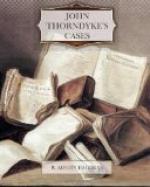We struck off into the wood, where last year’s dead leaves made the footprints almost indistinguishable, and followed the faint double track for a long distance between the dense clumps of bushes. Suddenly my eye caught, beside the double trail, a third row of tracks, smaller in size and closer together. Thorndyke had seen them, too, and already his measuring-tape was in his hand.
“Eleven and a half inches to the stride,” said he. “That will be the boy, Jervis. But the light is getting weak. We must press on quickly, or we shall lose it.”
Some fifty yards farther on, the man’s tracks ceased abruptly, but the small ones continued alone; and we followed them as rapidly as we could in the fading light.
“There can be no reasonable doubt that these are the child’s tracks,” said Thorndyke; “but I should like to find a definite footprint to make the identification absolutely certain.”
A few seconds later he halted with an exclamation, and stooped on one knee. A little heap of fresh earth from the surface-burrow of a mole had been thrown up over the dead leaves; and fairly planted on it was the clean and sharp impression of a diminutive foot, with a rubber heel showing a central star. Thorndyke drew from his pocket a tiny shoe, and pressed it on the soft earth beside the footprint; and when he raised it the second impression was identical with the first.
“The boy had two pairs of shoes exactly alike,” he said, “so I borrowed one of the duplicate pair.”
He turned, and began to retrace his steps rapidly, following our own fresh tracks, and stopping only once to point out the place where the unknown man had picked the child up. When we regained the path we proceeded without delay until we emerged from the wood within a hundred yards of the cottage.
“I see Mrs. Haldean has been here with Giles,” remarked Thorndyke, as he pushed open the garden-gate. “I wonder if they saw anybody.”
He advanced to the door, and having first rapped with his knuckles and then kicked at it vigorously, tried the handle.
“Locked,” he observed, “but I see the key is in the lock, so we can get in if we want to. Let us try the back.”
The back door was locked, too, but the key had been removed.
“He came out this way, evidently,” said Thorndyke. “though he went in at the front, as I suppose you noticed. Let us see where he went.”
The back garden was a small, fenced patch of ground, with an earth path leading down to the back gate. A little way beyond the gate was a small barn or outhouse.
“We are in luck,” Thorndyke remarked, with a glance at the path. “Yesterday’s rain has cleared away all old footprints, and prepared the surface for new ones. You see there are three sets of excellent impressions—two leading away from the house, and one set towards it. Now, you notice that both of the sets leading from the house are characterized by deep impressions and short steps, while the set leading to the house has lighter impressions and longer steps. The obvious inference is that he went down the path with a heavy burden, came back empty-handed, and went down again—and finally—with another heavy burden. You observe, too, that he walked with his stick on each occasion.”




